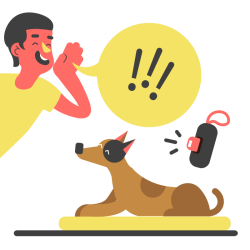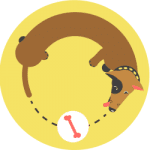In the Dogo App we use three main methods to train dogs: luring, shaping and capturing. We would like to give a quick overlook of each method and its pros and cons.
Capturing
This is catching and naming a certain behaviour – stretching, yawning, digging, that your dog does daily. For a few days walk around the house with a clicker and treats in your pocket. Just before you see the dog does the position you are capturing, e.g. bowing, say BOW, your dog bends his/her front legs, click and give a treat. Following your dog around and consistently naming and praising the behaviour, will teach the dog to associate the verbal cue with the action. In a short time, your dog will offer the behaviour on a cue. In order to select the right behavior to capture, it is important to observe your dog’s natural tendencies and identify the behaviors that they perform frequently. Once you have identified the behavior you want to capture, begin training with the clicker and treats as described in the paragraph. Over time, you will be able to capture more complex behaviors and shape them into tricks that your dog can perform on cue.
- Pros: Easy to teach if the behaviour occurs frequently. It requires mental effort from the dog to make an association cue-behaviour-award.
- Cons: Limited to natural frequent behaviours, requires your time following the dog around.
 Luring
Luring
Luring is presenting a piece of food in front of your dog’s nose and like with a magic wand luring, moving your dog into a wanted position or performing a motion. For example in Dogo’s trick Spin – you are holding a treat in your hand in front of the dog’s nose. You move your hand with the food and your dog follows the food and turns around his/her axis. Once your dog has learned a trick using a lure, it is important to transition to verbal commands so that your dog can perform the trick without the need for a treat. The process of transitioning to verbal commands is called “fading the lure”. To fade the lure, you can begin to introduce the verbal command as you present the lure, and gradually reduce the amount of food used until your dog will perform the behavior on verbal command alone.
- Pros: Fast, flexible, easy for beginners.
- Cons: Lures must be phased out early or dogs become dependent on the treat to do the trick. Requires little mental effort in problem-solving by the dog.
Shaping
Shaping requires your dog to think intensively, try different things and find out what behaviour gets him/ her rewarded. It is a great way to wear out, calm down and teach a dog to focus. Tricks have to be broken down in small steps and gradua
For example put a blanket on the ground First, click&treat for any interest in the blanket (glance). Later click&treat for walking in the direction of the blanket, then stepping on the blanket. As the session evolves, you become pickier and click only for sitting on the blanket, later for having all body on the blanket. Your dog will try all possible things in order to get the treat and your praise. As the command gets more complex, your dog will have to perfect his/her behaviour in order to get your approval.
When you advance on a trick, you make a trick slowly harder by varying 3Ds – distance, duration, distraction. When performing a trick make the distance between you and your dog greater, increase the duration of how long does a pup have to stay in a certain position or vary distractions when training like adding other people, music, food on the table, etc. This way your dog master the trick and is able to perform it in various situations.
Shaping can be used to teach a dog to fetch a specific object, crawl, or even play dead. It is important to remember that shaping requires patience and persistence, and that progress may be slow at times. However, with consistent training and positive reinforcement, any dog can learn complex tricks using shaping.
- Pros: clicker enables precise behaviour timing when shaping, this is brain intensive, requires creativity from the dog. Shaping gives you no limitations what a dog can learn.
- Cons: You have to break behaviour in small steps, move slowly so your dog does not get bored when trying. Requires an enthusiastic dog, who wants to learn and loves to interact with you.
Luring can be used to introduce a new behavior, capturing can be used to reinforce natural behaviors, and shaping can be used to refine and perfect a behavior. Dogo recommends using all 3 methods luring, shaping, capturing while training, in order to vary the skills that your dog develops. If you train your dog more than just basic obedience, shaping skills will come out very handy. However, the most important thing is to train your dog!

 Luring
Luring 




